C++使用thread类多线程编程
C++11中引入了一个用于多线程操作的thread类,简单多线程示例:
#include <iostream> #include <thread> #include <Windows.h> using namespace std; void thread01() { for (int i = 0; i < 5; i++) { cout << "Thread 01 is working !" << endl; Sleep(100); } } void thread02() { for (int i = 0; i < 5; i++) { cout << "Thread 02 is working !" << endl; Sleep(200); } } int main() { thread task01(thread01); thread task02(thread02); task01.join(); task02.join(); for (int i = 0; i < 5; i++) { cout << "Main thread is working !" << endl; Sleep(200); } system("pause"); }
输出:
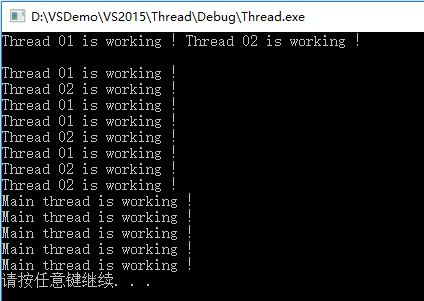
两个子线程并行执行,join函数会阻塞主流程,所以子线程都执行完成之后才继续执行主线程。可以使用detach将子线程从主流程中分离,独立运行,不会阻塞主线程:
#include <iostream> #include <thread> #include <Windows.h> using namespace std; void thread01() { for (int i = 0; i < 5; i++) { cout << "Thread 01 is working !" << endl; Sleep(100); } } void thread02() { for (int i = 0; i < 5; i++) { cout << "Thread 02 is working !" << endl; Sleep(200); } } int main() { thread task01(thread01); thread task02(thread02); task01.detach(); task02.detach(); for (int i = 0; i < 5; i++) { cout << "Main thread is working !" << endl; Sleep(200); } system("pause"); }
输出:
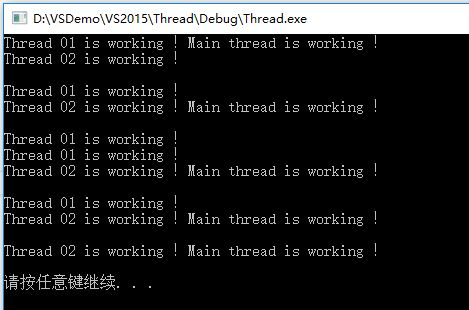
使用detach的主线程和两个子线程并行执行。
带参子线程
在绑定的时候也可以同时给带参数的线程传入参数:
#include <iostream> #include <thread> #include <Windows.h> using namespace std; //定义带参数子线程 void thread01(int num) { for (int i = 0; i < num; i++) { cout << "Thread 01 is working !" << endl; Sleep(100); } } void thread02(int num) { for (int i = 0; i < num; i++) { cout << "Thread 02 is working !" << endl; Sleep(200); } } int main() { thread task01(thread01, 5); //带参数子线程 thread task02(thread02, 5); task01.detach(); task02.detach(); for (int i = 0; i < 5; i++) { cout << "Main thread is working !" << endl; Sleep(200); } system("pause"); }
输出跟上例输出一样:
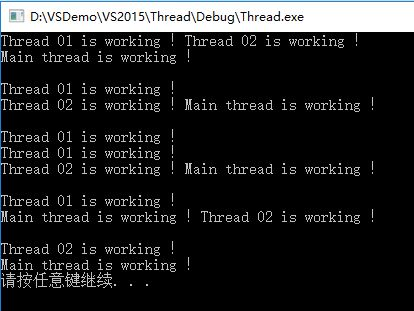
多线程数据竞争
多个线程同时对同一变量进行操作的时候,如果不对变量做一些保护处理,有可能导致处理结果异常:
#include <iostream> #include <thread> #include <Windows.h> using namespace std; int totalNum = 100; void thread01() { while (totalNum > 0) { cout << totalNum << endl; totalNum--; Sleep(100); } } void thread02() { while (totalNum > 0) { cout << totalNum << endl; totalNum--; Sleep(100); } } int main() { thread task01(thread01); thread task02(thread02); task01.detach(); task02.detach(); system("pause"); }
输出结果(部分):
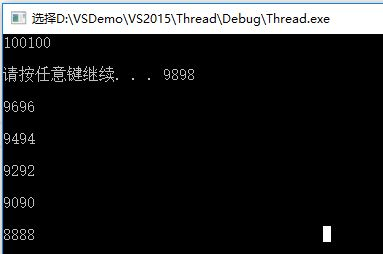
有两个问题,一是有很多变量被重复输出了,而有的变量没有被输出;二是正常情况下每个线程输出的数据后应该紧跟一个换行符,但这里大部分却是另一个线程的输出。
这是由于第一个线程对变量操作的过程中,第二个线程也对同一个变量进行各操作,导致第一个线程处理完后的输出有可能是线程二操作的结果。针对这种数据竞争的情况,可以使用线程互斥对象mutex保持数据同步。
mutex类的使用需要包含头文件mutex:
#include <iostream> #include <thread> #include <Windows.h> #include <mutex> using namespace std; mutex mu; //线程互斥对象 int totalNum = 100; void thread01() { while (totalNum > 0) { mu.lock(); //同步数据锁 cout << totalNum << endl; totalNum--; Sleep(100); mu.unlock(); //解除锁定 } } void thread02() { while (totalNum > 0) { mu.lock(); cout << totalNum << endl; totalNum--; Sleep(100); mu.unlock(); } } int main() { thread task01(thread01); thread task02(thread02); task01.detach(); task02.detach(); system("pause"); }
多线程中加入mutex互斥对象之后输出正常:
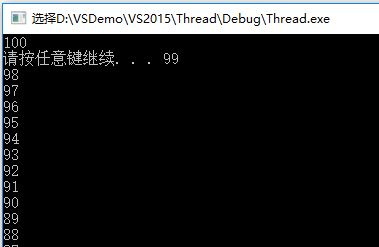





【推荐】国内首个AI IDE,深度理解中文开发场景,立即下载体验Trae
【推荐】编程新体验,更懂你的AI,立即体验豆包MarsCode编程助手
【推荐】抖音旗下AI助手豆包,你的智能百科全书,全免费不限次数
【推荐】轻量又高性能的 SSH 工具 IShell:AI 加持,快人一步
· winform 绘制太阳,地球,月球 运作规律
· AI与.NET技术实操系列(五):向量存储与相似性搜索在 .NET 中的实现
· 超详细:普通电脑也行Windows部署deepseek R1训练数据并当服务器共享给他人
· 【硬核科普】Trae如何「偷看」你的代码?零基础破解AI编程运行原理
· 上周热点回顾(3.3-3.9)